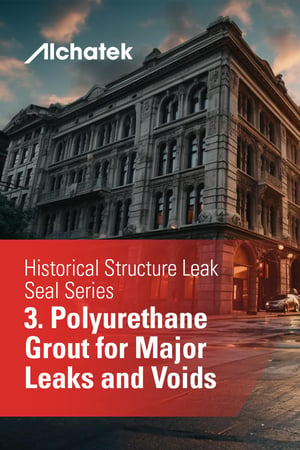
 In the realm of historical building preservation, polyurethane grouts stand out as a vital tool for managing structural repairs, particularly in dealing with significant leaks and voids. Polyurethane grouts are injectable resins that react with water to expand and solidify, forming a sturdy, waterproof seal. This characteristic makes them especially suitable for repairing and reinforcing structures that have been compromised over time.
In the realm of historical building preservation, polyurethane grouts stand out as a vital tool for managing structural repairs, particularly in dealing with significant leaks and voids. Polyurethane grouts are injectable resins that react with water to expand and solidify, forming a sturdy, waterproof seal. This characteristic makes them especially suitable for repairing and reinforcing structures that have been compromised over time.
Mediating Major Leaks and Voids with Polyurethane Grouts
Polyurethane grouts excel in addressing two critical issues in historical buildings:
- Sealing Heavy Leaks: When faced with substantial water ingress, these grouts expand upon contact with moisture, effectively sealing off heavy leaks and their set time can easily be field adjusted.
- Filling Voids: They are adept at filling larger voids in the soil behind walls or underneath foundations, bolstering the structure and preventing future damage.
The Economic Advantages of Polyurethane Grouts
Polyurethane grouts are not just effective; they are also economically and materially prudent:
- Cost-Effectiveness: They offer a cost-efficient solution to major structural problems, mitigating the need for more invasive and expensive repairs.
- Material Compatibility: These grouts work well with a variety of traditional building materials, including stone, brick, and concrete, making them versatile for different historical structures.
Pairing Polyurethane with Acrylate Grouts
After addressing major leaks and voids with polyurethane grouts, any remaining slower leaks can be meticulously and precisely sealed using acrylate grout injections. This two-step approach ensures comprehensive leak sealing:
- Polyurethane for Major Issues: Initially, use polyurethane grouts for significant heavy leaks and soil voids.
- Acrylate for Precision: Follow up with acrylate grouts for finer, more precise crack injection or curtain grouting, ensuring a cleaner finish and maintaining the aesthetic integrity of the historical structure.
Hypothetical Scenarios: Showcasing the Combined Strength of Polyurethane and Acrylate Grouts
Let's envision how this dual approach can be applied:
- Scenario 1: The Gilded Age Theater: With a deteriorating stone foundation, this historic theater first uses polyurethane grouts to address large voids and major leaks. Subsequently, acrylate grouts are injected into smaller hairline cracks, providing a refined and less intrusive repair, and preserving the theater's historic charm.
- Scenario 2: The 18th-Century Brick Warehouse: Here, a brick warehouse faces extensive water leakage through its old walls. The initial application of polyurethane grouts stops the major leaks and fills voids. Then, acrylate grouts are used to seal smaller residual leaks, ensuring a thorough and aesthetically pleasing restoration.
This dual-grout strategy effectively combines the robust sealing power of polyurethane grouts with the precision and cleanliness of acrylate grouts, offering a comprehensive solution for preserving historical structures.



